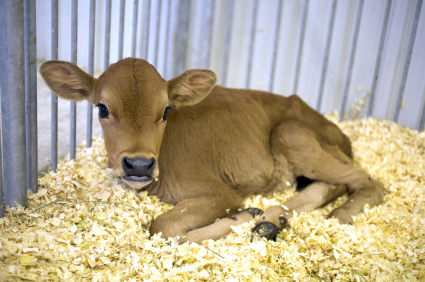For small landholders wanting to make a success of calf rearing and make a supplementary income from it, calf housing will be an important consideration. Providing suitable housing for calves at night and in bad weather for the first 4 weeks of their life can result in growth rates of up to 25% above those of non-housed calves.
Individual or group housing?
There are two basic approaches to housing calves. They can be housed individually in pens or small huts or together in small groups. Both approaches have their advantages as well as some disadvantages.
Individual housing has the advantage that it’s easier to provide calves with individual attention and potentially gives greater control over infectious diseases. Problems of calf testicle/pizzle and ear sucking are also avoided. However, tending to calves in individual housing does tend to require more labour input. In addition, individually housed calves can experience socialising problems and post-weaning growth checks once they are introduced to other calves.
For small landholders who are time poor and rearing calves part time, group housing can provide significant time savings. Group housing is effective so long as continual attention is paid to shed hygiene and the progress of each individual calf is monitored well.
 |
Successful calf housing
Few problems are likely to occur with calf housing if the fundamentals of warmth, ventilation and hygiene are addressed and continually monitored. It makes good economic sense to use old buildings such as old houses and sheds for rearing calves, but again, make sure to address the basics of warmth, ventilation and hygiene when doing so. Ensure any sharp edges are removed as well as anything potentially poisonous or dangerous (such as lead paint, old car batteries or bailing twine), because calves will lick and suck anything and everything.
Where possible, housing should be positioned towards the sun and away from the prevailing wind. Good ventilation must be present with openings at both ends of the structure – not just the front – to ensure there is no build-up of ammonia gases from dung and urine. However, there shouldn’t be so much ventilation that it causes drafts. Where correctly positioned, even simple open-ended hoops of galvanised iron of sufficient height and length can provide the required warmth and shelter from rain.
Calf bedding materials
Calf bedding can be untreated wood chips, shavings, sawdust, straw, or shredded paper – in that order of preference. Don't use mouldy hay. The mouldy air is bad for them, as is nibbling at it, and calves will nibble at everything.
Untreated finely cut wood chips are the best as they 'move' to accommodate dung and urine, whereas fine sawdust will become sticky and wet.
Replenish the calf bedding with a fresh layer daily. It’s fine to overlay free-draining soil with bedding. Concrete flooring can actually be the worst base to have, unless the drainage from the floor area is top notch. If using converted sheep pens in a woolshed, ensure any draughts emanating from under the sheep grating are eliminated, as these are known calf killers.
Calf shed cleaning and hygiene management
Prior to any new calf rearing season and introduction of new batches of calves, liberally spray the pens and their surrounds with an effective disinfectant bactericide/viracide such as VirkonTM. Avoid overcrowding by allowing a least one square metre (1m2) per calf and keep batch sizes down to a maximum of 20 per pen. Don't shift calves between groups and remove any scouring calves from groups immediately for treatment.
As pointed out in Calf rearing – small farmers’ guide to feeding and raising calves, in addition to full cream milk fortified with salt and trace elements, calves require in-pen access to fresh water and quality high clover content hay from day one to ensure proper rumen development. They should also have daily access to fresh pasture, but not when it is raining. If calf meal supplements are used, feed these in the evenings once the birds have roosted and overturn meal feeding troughs during the day to deny birds access, as they can quickly spread scours and other disease as they hop from a calf stool to a feeding trough.
Where to from here?
For further information on raising calves we recommend you purchase a copy of Calf Rearing – A Practical Guide. This book provides small farmers with information on calf biology, evaluating alternative feed resources, and developing a full management strategy for calf rearing.
About the author
 |
The author, Roger Martyn has spent 20 plus years working in agriculture and horticulture since graduating from Massey University with an Agricultural Science degree. He has helped many farmers improve their farm productivity and profitability as well as often increasing the enjoyment they got out of farming. |



